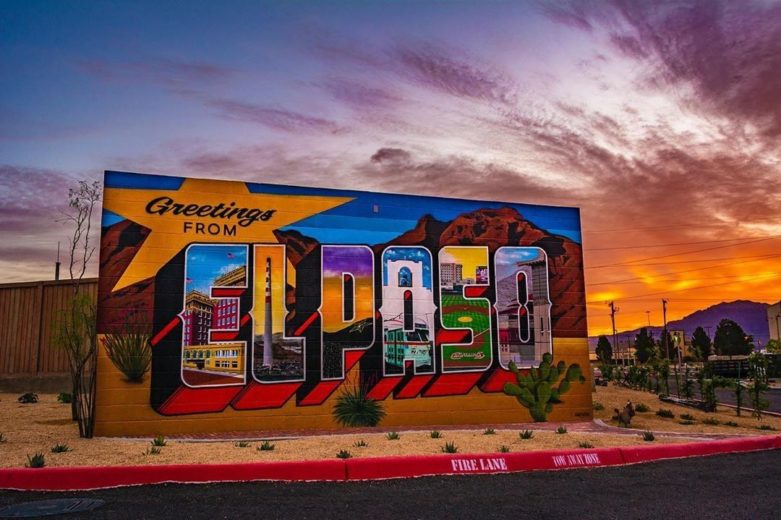
I recently visited El Paso, Texas. I was there the same weekend as the mass shooting that claimed the lives of 22 people and injured 36. El Chuco, as us Chicanos call it, is a city steeped in history. I learned a lot about El Paso during my short, but eventful trip.
El Paso shares a borders with Las Cruces, New Mexico and Juarez, Chihuahua in Mexico. The combined metropolitan area is known as the Borderplex. It makes up the largest bilingual workforce in the entire Western Hemisphere. It exemplifies La Frontera. It’s roots run deep from the Texas Revolt of slave owners to the American Civil War to the Mexican Revolution. It is the largest Mexican majority city in the entire United States. I noticed this as I sat in a coffee shop at Cielo Vista Mall. “Everyone here is Mexican. This is what California will look like in 15-20 years,” I thought as I sipped my drink.
The very next day, a murderous coward motivated by white supremacy drove nine hours to that same shopping center to kill its citizens for that same reason. The Walmart that was attacked sat adjacent to the shop I had been in. The shop was put on lock down when the mass shooting occurred.
I was nearby when the shooting occurred. I received a warning on my cell phone to avoid the area because of an active shooter. Honestly, when I first saw the notice it didn’t faze me. Perhaps it is the result of being desensitized to such headlines. Just days earlier a similar event happened in Gilroy, near my hometown of Stockton, at the Garlic Festival. Stockton is one of the most violent cities in America. Shootings occur there regularly. Even seeing various law enforcement agencies including the Border Patrol, blocking off the entrances, I still didn’t think it was that major. I’ve seen similar perimeters set up in my hometown too often.
Talking to people who were in the mall, like PFC Glendon Oakley, a soldier in the US Army, helped me realize the potential severity of the situation. He spoke about the pandemonium. People deciding whether to sit in a locked mall with potential multiple shooters or whether to run. He and others made ran grabbing unattended children along the way.
As I walked further towards my destination I saw members of the El Paso SWAT team staging by an entrance. As I tried to take some pictures and get some video, the SWAT team drew their rifles on me. They ordered me to put my hands in the air as they approached at gunpoint. My biggest fear as I knelt on the scorching hot pavement was making any sudden move giving them a reason to accidentally shoot me. I could sense their nervousness. I was detained along with a father and son who were just trying to get in their car and leave.
After being handcuffed and speaking to the officers, I realized how perilous the situation was. One officer told me it was “ a bloodbath” inside the Walmart. They did not know how many shooters were involved. They explained that we were detained because the situation was critical and our identities unknown. They ran our identification cards and cleared us to leave after about 20 minutes.
When the details emerged, a sense of shock hung over the city and America’s collective consciousness. I too was in disbelief. However, knowing history I knew this was not a new occurrence in the region or the city’s history.
Racial violence towards Mexican/indigenous people, unfortunately, has always been a reality en La Frontera. In fact El Paso was founded in 1680 as the result of violence in Sante Fe, New Mexico. There, the indigenous “Pueblo” people revolted against Spanish colonizers after generations of violence and oppression. It forced Spanish authorities to relocate after 400 Spaniards and 600 were killed.
Even one of the most iconic organizations of the era, the Texas Rangers, were born from this racial violence. The Texas Rangers were akin to the Ku Klux Klan. Except they didn’t operate outside the law–they were the law. Historical scholars have estimated that the Texas Rangers and lynch mobs killed an estimated 5,000 Mexicans in racially motivated violence. They remain an official law enforcement organization.
The struggle against hatred continues. El Paso should be a lesson for America, not only in the current gun debate, but also about its national past. If El Chuco is anything it is resilient. I learned it is perennially one of the top three safest cities in the USA. Considering its proximity to Juarez, Mexico is one of the most dangerous cities in the world, this is a feat.
Everybody I spoke to about the shooting kept saying how it did not reflect the spirit of El Paso. However, Mexicans I spoke to said they feel like they have a target on their backs and El Paso is now on the front line of a battleground. A historical battleground born from a racially motivated war generations prior. Regardless, their spirits remain optimistic, friendliness remains persistent, hope remains present, and El Chuco remains strong. Hopefully we will all finally learn from its history and present.
